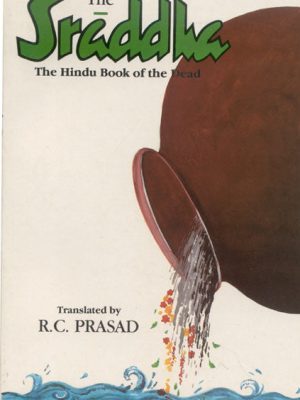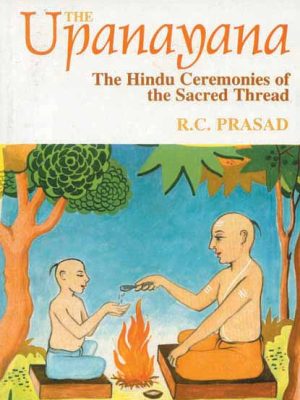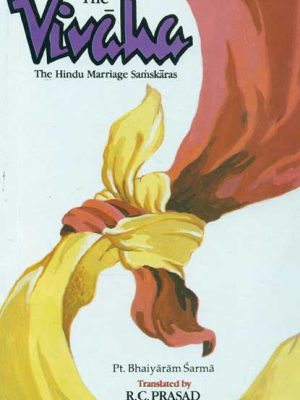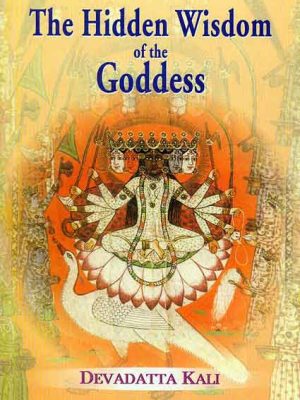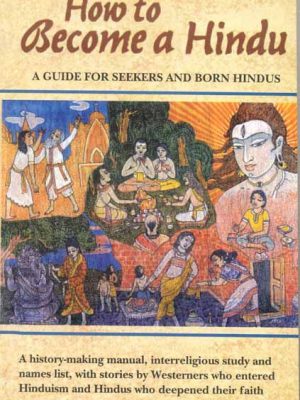
Motilal Banarsidass Publishing House
-
The Mandukya Upanisad and the Agama Sastra: An Investigation into the Meaning of the Vedanta
The Mandukya Upanisad and the Agama Sastra: An Investigation into the Meaning of the Vedanta
The Mandukya Upanisad and the Agama Sastra: An Investigation into the Meaning of the Vedanta
₹535.00 -
Apad-Dharma in the Mahabharata: How to Face Calamities at Personal, State, and Global Levels
Apad-Dharma in the Mahabharata: How to Face Calamities at Personal, State, and Global Levels
The literal meaning of the Sanskrit word “Apaddharma” is “dharma appropriate at the time of calamity”. The Mahabharata’s use of this expression implies that, in the opinion of the author of this epic, the traditional varnashramadharma would not prove to be strong enough to protect the society, if and when there is a calamity. Therefore, Vedic scholars ought to have welcomed the messages of Apad-dharma when the society was actually attacked by external forces during the premodern period.
The historical background of the present study poses an important, academic question: “How could the Indian society have protected itself against external attacks during the pre-modern period?” Research-based answers to such Indiarelated questions occupy the initial part of this book to which a global dimension has been added by digging deep into Mahabharata’s innumerable stories. Results of innovative investiga-tions into the general question “How to face calamities at personal, state and global levels”, are presented here in terms of a modern, scientific framework, and expressed in a non-denominational
terminology, relevant to the problems of the 21st century. Readers from all parts of the world can get a strong message of social responsibility from this book, and accordingly make their contribution to the cause of world peace.
₹225.00 -
The Call of the Upanishads
The Call of the Upanishads
The seers and sages of Ancient India revealed fundamental principles of perennial philosophy. The Upanishads contain the essential principles of this perennial-this ageless philosophy. They contain a large number of inspiring and instructive passages and verses. It has not been possible to include all of them in this book. For the purposes of this book the author has taken those verses and passages that have a bearing on the mystical teaching of the Upanishads. It is mysticism which is the very core of the Upanishads-and so in understanding its mysticism one comes to the heart of the sublime and magnificent teaching of the Upanishads. In this age, where science and technology may lead us into a world devoid of meaning and significance. Modern man needs today a meaningful philosophy if the achievements of science are not to lead him to greater and greater destruction-but to sublime and majestic heights of creative living. It is in the Vision of Life given by the Upanishads that man can find the fundamental philosophy of Creative Living-a philosophy that can serve as a Beacon Light even in the midst of surrounding darkness, a philosophy that can lead him from the unreal to the Real, from darkness to Light, from death to Immortality.
₹495.00The Call of the Upanishads
₹495.00 -
The Sraddha: The Hindu Book of the Dead (A Treatise on the Sraddha Ceremonies)
The Sraddha: The Hindu Book of the Dead (A Treatise on the Sraddha Ceremonies)
Of the sixteen samskaras which encompass a Hindu life the last one is performed for the dead by their sons or grandsons or relatives. Many passages in the Puranas and Dharmasastras extol the role of the son in the life of devout Hindu. The present book deals with the rite of Sraddha and vindicates the popular belief that Sraddha, being an important topic, forms an integral part of Hindu Dharmasastra. The belief in the after-death survival of deceased ancestors and their separate world belongs to the Indo-Iranian period and as such is pre-Vedic. Ancestor-worship for one’s prosperity, continuation of one’s race, is as old as the Rgveda. Preface, Introduction, The Antyesti Samskara, Appendices, Glossary.
₹195.00 -
The Upanayana: The Hindu Ceremonies of the Sacred Thread
The Upanayana: The Hindu Ceremonies of the Sacred Thread
It appears from ManuÍs institutes that they are meant as much for the householder in the
second order of life_garhasthya_as for the student. The laws for the brahmanas are severer and they are expected to subject themselves to harder physical and mental disciplines, forsaking all attachment of their organs to sensual pleasures. A brahmana student must keep them under complete
control and bear in mind that desire is never extinguished by the enjoyment of desired objects; it only grows stronger like a fire fed with clarified butter.
But all this appears to have vanished. It is unfortunate that many brahmanas, starkly ignorant
of the Vedic rcas and scriptural teachings, are often called upon to perform the ceremonies. There is substance in their contention that since the times have changed, the ceremonial laws too must be thoroughly revised and modified to bring them in conformity with the present-day ethos. They also argue that, as the mantras are in Sanskrit, very few people are able to chant them with complete understanding of their inherent meaning and importance. It is to meet their demand for a simple text with explanatory instructions that this book has been written. Its readers can be scholarly priests or non-scholarly householders or both. To some this may sound a profanation of the ceremonial laws, but the intention is pious and therefore this attempt to democratize and
expound the esoteric is forgivable.
Upanayana is one of the sixteen samskaras or purificatory rites in which a boy is invested with the sacred thread and thus endowedwith second or spiritual birth and qualified to learn the Veda by heart. In this ceremony the boy goes to an Acarya well-versed in the Vedas with a view to be initiated into Vedic studies or a Guru draws a boy towards himself and initiates him into one of the three twice-born classes. From the day the initiation ceremony takes place the young celibate commits himself to a life of austerity and abstinence; he chooses to lead a life rigorously disciplined by vows and disciplinary rules.
₹275.00 -
The Vivaha: The Hindu Marriage Samskaras
The Vivaha: The Hindu Marriage Samskaras
Ceremonial rites and rituals occupy a place of utmost importance in the life of a devout Hindu. In fact there are no vital actions-birth, initiation, marriage, death etc.-which can be allowed to be performed without its appropriate rite or samskara. The number of samskara has been fluctuating but was finally fixed at sixteen.
Marriage is the most important and elaborate out of these sixteen samskaras. Manu enjoins that rituals should be performed in the case of a virgin for legalizing the marriage, legitimatizing children and avoiding public scandal.
The mantras used in the nuptial rites being in Sanskrit are beyond the comprehension of not only the average Hindu but even the common priests entrusted with the duty of conducting the rituals. To overcome this difficulty the present book was originally prepared in Hindi and is now translated into English with the mantras etc. romanized for the benefit of those who do not have adequate knowledge of Hindi, for example especially those whose forefathers had migrated to remote countries during the last one hundred years or so
₹395.00 -
Ramayana At A Glance
Ramayana At A Glance
The world is the stage on which the Lord played the part of Rama as the ideal son, brother, husband, step-son, and king. The story of Rama and Sita is verily the story of humanity. Sita, Rama’s devoted consort, enacted the role of the dutiful, chaste wife who cared for nothing but her beloved Rama. Lakshmana was the perfect brother, and Bharata and Shatrughna were exemplary in their devotion to their step-brother, Rama.
The next main character, Hanuman, is the embodiment of a surrendered devotee the pinnacle of Bhakti Yoga. The ten-headed Ravana, who plays the antagonistic role, symbolizes our ten senses (5 senses of knowledge and 5 senses of action). During the war, Rama beheads Ravana, which is characteristic of a yogi conquering the senses.
The characters in the Ramayana relate to our own human drama. The Ramayana teaches us a way of life. It shows how to have pure love among family members and toward society and gives us a
method to control the ten senses and the mind for inner peace and spiritual bliss.
Singing the LordÍs name on the gross plane can bring us to the transcendental level where sound manifests as pure energy. The name and form disintegrate in Pure Consciousness and ultimate peace is experienced. Repetition of the Lord’s name in the form of japa or kirtan will bring the transcendental, blissful experience attained by the great devotees and saints like Bhakta Mira
Bai, Tukaram, and in the present time, Sri Sant Keshavadas, Santji has followed the tradition of our great saints and devotees of the past and has now brought the story of the Ramayana for 20th century man.
₹345.00Ramayana At A Glance
₹345.00 -
The Hidden Wisdom of the Goddess
The Hidden Wisdom of the Goddess
The Hidden Wisdom of the Goddess is an extended meditation in the form of a novel that follows the Devimahatmya’s basic outline, condensed here and expanded there in freely imaginative ways. In the Devimahatmya the seer Medhas teaches through the language of myth, which cries out for interpretation, because little is spelled out. The Hidden Wisdom to the Goddess communicates the hidden wisdom of the holy man’s teachings simply, directly, and eloquently.
Most of the book consists of newly invented scenes, incidents, and conversations between Medhas and his two disciples, the king Suratha and the merchant Samadhi. As the book progresses, the main characters become fleshed out and take on a life of their own. All the while, the writing probes ever deeper into the mysterious of human existence.
₹295.00The Hidden Wisdom of the Goddess
₹295.00 -
Karmakand-Pradeep: Dashakarmadipaddhti
Karmakand-Pradeep: Dashakarmadipaddhti
₹175.00 -
Manusmriti (Dwitiya Adhyaya)
Manusmriti (Dwitiya Adhyaya)
₹100.00Manusmriti (Dwitiya Adhyaya)
₹100.00 -
Yagyatattvaprakash-Chinnswami Shastri Virchit
Yagyatattvaprakash-Chinnswami Shastri Virchit
₹445.00 -
How to Become a Hindu: How To Indeed A History Making Manual Presenting An
How to Become a Hindu: How To Indeed A History Making Manual Presenting An
How to Become a Hindu: How To Indeed A History Making Manual Presenting An
₹750.00 -
Kailash Mansarovar: Diary of a Pilgrim
Kailash Mansarovar: Diary of a Pilgrim
This profusely illustrated travelogue is a tale about fancies and fears, adventures and aspirations, expectations and disillusions, escapes and retreats experienced by a team of adventurous pilgrims. This is a story of an unforgettable odyssey to the holy Mount Kailash and the sacred Mansarovar describing mysteries connected with the land capturing the intangible air of faith and pilgrimage. This travelogue takes us on a journey to the wild, seldom travelled northern route visiting the remote cities, towns and monsteries of mysterious Tibet. It is a gripping story of pilgrims who aspire to see Gods living in the wilderness of the remote holy land. This is an engrossing, touching and remarkable account of a picturesque travel with nice imagery describing majestic mountains, turquoise lakes and virgin rivers of Tibet. Written in a brilliant style, it is a dramatic record that succeeds in imparting onto the readers some of the intensely experienced emotions that will remain long in memory. This book has been included in the Tibetan Travel Classics, Pilgrims Publishing, Varanasi, India and Pilgrims Book House, Kathmandu, Nepal.
₹225.00 -
Shrimadbhagavat Ka Gyan, Deen Dukhi ki Seva Mahaan
Shrimadbhagavat Ka Gyan, Deen Dukhi ki Seva Mahaan
₹195.00 -



